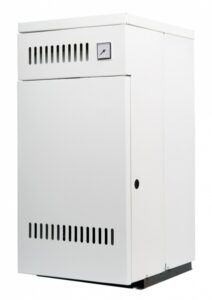Whenever you need to turn on your furnace to warm your house during the chilly Minnesota winters, you’ll spend money—regardless of whether you’re using gas or electricity. But how much money you spend will depend on the efficiency of the furnace, i.e. how well it converts its energy source into heat.
Efficiency in furnaces has become more important than ever as people look for ways to cut down on energy consumption and benefit the environment. The technology of furnaces has advanced to make high-efficiency units more efficient than ever. In this post, we’ll look into furnace efficiency and how it’s measured to help you understand its importance.
Furnace Efficiency Rating: AFUE
The standardized measurement of the energy efficiency of a furnace is AFUE, which stands for Annual Fuel Utilization Efficiency. AFUE is expressed as a percentage of the amount of fuel turned directly into heat, with the remainder lost to exhaust, as averaged over a year of use. For example, a mid-efficiency gas furnace with 85% AFUE will turn 85% of the natural gas it burns into heat sent into the home, while the remaining 15% is lost to exhaust.
It’s important to remember the “Annual” part of AFUE. A furnace with 95% AFUE will not work at 95% efficiency all the time, but will average it over a year of use. You can expect a furnace to often work below its AFUE and sometimes above it.
The Electric Furnace Complication
AFUE can be a touch confusing when applied to electric furnaces because all electric furnaces have 100% AFUE. This is because of the way electric furnaces work: they don’t burn fuel and lose energy to exhaust, so they naturally convert all of their electrical energy into heat. The 100% AFUE rating doesn’t mean an electric furnace is less expensive to run than a gas furnace. Often, electric furnaces are more expensive to run because electricity is a more costly energy source locally.
High-Efficiency Furnaces
Standard furnaces are known as mid-efficiency, and they have AFUE ratings from as low as 80% (the current minimum allowed for manufacturers) to as high as 93%. High-efficiency furnaces can reach up to 98%. They’re able to achieve this high level of efficiency thanks to having secondary heat exchangers, multi-stage burners, and variable-speed blowers.
High-efficiency furnaces cost more than mid-efficiency ones, although they can pay back their upfront cost through lifetime energy savings. A high AFUE isn’t a guarantee of savings, since a poorly installed or incorrectly sized furnace will waste power no matter what. However, if you have professionals work with you to select and install your high-efficiency furnace, it may be a worthwhile investment that will result in significant savings over time. High-efficiency furnaces have other benefits: more even temperature distribution, fewer temperature fluctuations, safer operation, and less dry indoor air.
When it comes to furnaces in Eden Prairie, MN and throughout the Twin Cities, you can always rely on Reliance for the best advice and service. If you’re interested in a high-efficiency furnace, we’re glad to help you find the ideal unit to meet your needs.

